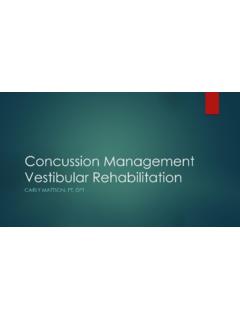Transcription of Functional performance testing following knee ligament injury
1 Functional performance testingfollowing knee ligament injuryNicholas C. ClarkOutcome measurement in sports physiotherapy is directed at identifying an athlete's ability totolerate the physical demands inherent in sport-speci c activity and prevent re- injury on return-to-competition. Outcome measures currently utilized following anterior cruciate ligament (ACL) injuryinclude clinical, Functional performance test (FPT), and subjective measures. The FPT simulates theforces encountered during sport-speci c activity under controlled clinical conditions, the use of theFPT increasing since traditional clinical outcome measures, such as knee joint laxity and isokineticquadriceps muscle strength, demonstrate weak to moderate and often insigni cant relationshipswith Functional tasks.
2 Many FPTs, such as hop, leap, jump, sprint, and agility FPTs, may beadministered to an athlete following knee ligament injury . However, when selecting a FPT for theassessment of knee function, the clinician must acknowledge issues relating to reliability, validity,data analysis, and at what point in the rehabilitation process a FPT should be administered if thedata generated are to be meaningful and useful. Therefore, the purpose of this paper is to presenta comprehensive and detailed review of the FPT literature in order to assist the sportsphysiotherapist with the clinical application of a FPT to an athlete following knee ligament injury .*c2001 Harcourt Publishers LtdIntroductionOutcome measurement is emphasized inphysiotherapy to assess, evaluate and justifyclinical practice (Chartered Society ofPhysiotherapy 1994;Rothstein 1985;Task Forceon Standards for Measurement in PhysicalTherapy 1991).
3 In sports physiotherapy,outcome measurement is also directed atidentifying an athlete's ability to tolerate thephysical demands inherent in sport-speci cactivity and prevent re- injury on return-to-competition. With regard to the knee , outcomemeasures currently utilized following anteriorcruciate ligament (ACL) injury include clinical, Functional performance test (FPT), andsubjective measures. Clinical and FPT measuresare popular for administration to both anteriorcruciate ligament de cient (ACL-D) andanterior cruciate ligament reconstruction(ACL-R) athletes due to their ability toobjectively quantify knee function (Borsa et ;Miller & Carr 1993).Clinical measures utilized with ACL-D andACL-R athletes include range of motion (ROM)emphasizing terminal knee extension bygoniometry, passive heel lift, and prone heelheight (DeCarlo et al.)
4 1994;Sachs et al. 1989;Shelbourne & Nitz 1990), anterior tibialdisplacement by manual ligament testing andarthrometer (Daniel et al. 1994;Neeb et al. 1997;Sekiya et al. 1998), knee and thigh circumference(Bach et al. 1994;Clark et al. 1999;Lephart et ), isokinetic quadriceps and hamstringmuscle strength (Bach et al. 1994;Lephart et ;Natri et al. 1996;Sekiya et al. 1998;Wilket al. 1994), isometric and isotonic hip and kneeextensor muscle strength (Borsa et al. 1998;Clark et al. 1999;DeCarlo et al. 1994;Hooperet al. 1998;Sekiya et al. 1998), proprioception bythreshold to detection of passive motion andre ex hamstring contraction latency (Beard et ;Borsa et al. 1998;MacDonald et al. 1996;Wojtys & Huston 1994), static balance (Borsaet al.
5 1998;Harrison et al. 1994), andradiography (Daniel et al. 1994).Review Article*c2001 Harcourt Publishers LtdPhysical therapy In Sport(2001)2,91 10591doi : , available online at onNicholas C. ClarkBEd (Hons), BSc(Hons), MCSP, CSCS,Physiotherapist,Royal Free Hospital,Royal FreeHampstead NHST rust, Pond Street,London NW3 2QG,UK. Tel: +44 20 77940500, ext 4059 Functional performance test measuresutilized with ACL-D and ACL-R athletesinclude hop tests (Barber et al. 1990;Broskyet al. 1999;Daniel et al. 1982;Eastlack et ;Noyes et al. 1991;Rudolph et al. 1999),leap and jump tests (Juris et al. 1997;Risberg &Ekeland 1994), and linear sprint, agility, andstair climbing tests (Barber et al. 1990;Fonsecaet al. 1992;Gauf n et al. 1990;Lephart et ,1991,1992,1993;Risberg & Ekeland 1994;Tegner & Lysholm 1985;Tegner et al.
6 1986). Ahop FPT involves take-off and landing on thesame leg. A leap FPT involves take-off andlanding on opposite legs. A jump FPT involvestake-off and landing on both legs. A running orstair climbing FPT involves the rapid cyclicalalternation between legs. Consequently, hoptests are the preferred type of FPT due toutilization of the uninjured limb as a control forwithin-subject between-limb comparisons, andas a reference against which discharge fromrehabilitation and return-to-competition may bedetermined (Anderson & Foreman 1996;Barberet al. 1990;Borsa et al. 1998;Daniel et al. 1982;Noyes et al. 1991;Sapega 1990). However, itshould be acknowledged that a FPT may be assimple or gross a performance as desired by theclinician, such as hopping or kicking a football, many FPTs, perhaps in particular ahop FPT, may not be truly sport-speci c, somecritics might question their use as ameasurement tool.
7 However, in the absence ofsophisticated laboratory-biased kinematic andkinetic analyses ( 3-D motion analysis, forceplate analysis, etc), there is currently nomeasurement tool other than a FPT available tothe sports physiotherapist for theclinicalquanti cation of lower limb FPT is popular because it requiresminimal space, equipment, time, and personnelfor its administration in the standard clinicalcontext (Barber et al. 1992;Keskula et al. 1996;Noyes et al. 1991), and because traditionalclinical outcome measures predominantlydemonstrate weak to moderate and ofteninsigni cant relationships with Functional tasksin ACL-D, ACL-R, and uninjured subjects(Table 1). According toVincent (1995),a`strong' relationship (correlation) exists betweenmeasures (variables) when the correlationcoef cient (r) and `signi cant' ( ).
8 Correlation coef cients of are considered `weak' and`moderate', respectively (Vincent 1995). If thecorrelation coef cient is `insigni cant' ( ), the relationship is due to chance andhas little application to clinical practice(Green eld et al. 1998a). However, withreference toTable 1, clinicians should not beconfused by the assignment of a signi cantPvalue to weak or moderate correlationcoef cients, since considering thePvalue aloneresults in misinterpretation of the relationshipbetween variables (Di Fabio 1999). A study'sassignment of a signi cantPvalue to acorrelation coef cient has the potential to bedeceptive and misleading since statisticalsigni cance and weak relationships can occursimultaneously (Di Fabio 1999). Therefore,clinicians should consider the magnitude of rbefore the level of signi cance (P), since it is themagnitude of r that indicates the degree towhich two variables are related (Di Fabio 1999;Green eld et al.)
9 1998a). A signi cant r valuedoesnotautomatically mean there is a strongrelationship between two variables (Di Fabio1999). Consequently, considering thepredominantly weak to moderate relationshipsbetween traditional clinical outcome measuresand Functional tasks illustrated inTable 1,nosingle outcome measure is considered optimalfor the evaluation of intervention followingACL injury (Borsa et al. 1998;Miller & Carr1993;Neeb et al. 1997), and clinical outcomemeasures alone are considered insuf cient indetermining an athlete's readiness for return-to-competition (Anderson & Foreman 1996;Bandy1992;Keskula et al. 1996).A FPT measures joint laxity/mobility, muscleextensibility ( exibility), muscle strength andpower, proprioception, neuromuscular control,dynamic balance, agility, pain, and athlete-con dence simultaneously (Anderson &Foreman 1996;Barber et al.
10 1992;Lephart 1994;Lephart et al. 1992;Noyes et al. 1991;Tippett &Voight 1995). Consequently, a FPT re ects a`cumulative effect' since it is unable to identifyde cits in speci c variables. However, the FPTis still a useful measurement tool for theclinician because it:.is a quantitative measure utilized tode nefunction and/or outcome92 physical therapy in Sport(2001)2,91 105*c2001 Harcourt Publishers LtdPhysical therapy in SportFunctional performance testing following knee ligament injuryTable 1 Relationship between clinical and Functional performance test measuresClinical measureFunctional performance test StudySubjectsrPKnee joint ROMS huttle sprintLephart et al. (1988)ACL-D (n 18) Not statedSemicircular manoeuvreLephart et al.









